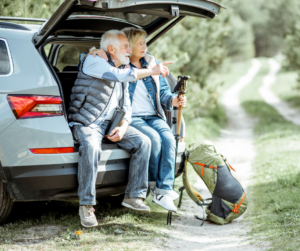How to Stay on Your Feet During Summer Travel: Fall Prevention Tips for Adventurers

Summer travel is all about new experiences, but unfamiliar environments, varying terrains, and changes to routine can increase the risk of falling; especially for older adults. While it’s true that we can’t prevent every fall, we can reduce the chances of a serious one by planning ahead and taking a few smart precautions. This blog focuses on fall prevention strategies specifically tailored to travelers, so you can enjoy your summer adventures safely and confidently.
Step 1: Make Your Travel Environment Safer
Most fall prevention tips focus on the home—and for good reason—but summer travel introduces new challenges. Whether you’re staying in a hotel, rental property, or with family, take a few moments to inspect and adapt to your surroundings.
Indoor Travel Safety Tips
- Check stair railings wherever you’re staying. If stairs lack handrails, ask for a different room or consider bringing a cane or travel-friendly support device—portable grab bars are not recommended as they may not be secure.
- Ensure adequate lighting. Bring a plug-in nightlight or a small flashlight to illuminate the paths from bed to bathroom. Be mindful of situations where there is a change from bright light to dark and take a moment for your eyes time to adjust.
- Non-slip footwear: Avoid flip-flops or loose sandals. Choose travel shoes with good tread and support.
- Bathroom precautions: Consider packing a non-slip mat or water shoes to use in the shower. If grab bars are missing, avoid holding onto towel racks—they’re not designed to bear weight.
- Clear walkways: Keep suitcases and bags out of walking paths and store them under the bed or in a closet to avoid tripping.
Outdoor Travel Considerations
- Uneven surfaces: Historic cities, nature trails, and beaches can pose fall risks. Always scan your path ahead. Consider using a walking stick or hiking poles for areas that are potentially uneven.

- Portable traction gear: If traveling to mountainous or unpredictable weather regions, consider packing YakTrax or MICROspikes for added grip [1][2].
- Stay hydrated: Carry a refillable water bottle and take regular sips, especially in warm weather or at higher altitudes.
- Protect your eyes: Wear sunglasses with UV protection to reduce glare and improve visibility while walking or sightseeing outdoors.
- Cell phone distractions: Avoid using your phone while walking in unfamiliar or crowded places—especially airports and tourist attractions.
Step 2: Do a Pre-Trip Body Check
Before you hit the road, take a moment to assess your physical health. Many falls are linked to changes in our vision, balance, or hearing, all of which can be subtly affected by travel fatigue or dehydration.
Vision: Poor vision significantly increases fall risk. A 2010 study found that cataract surgery reduced the incidence of falls by one-third [3], and research from the VISIBLE study showed that switching from multifocal to single-vision lenses improved stability by up to 40% [4].
Hearing and Balance: Hearing loss has been associated with increased fall risk, likely due to its effect on spatial awareness and balance [5]. Inner ear (vestibular) issues can cause dizziness, particularly in new environments or at high altitudes. If you’re prone to vertigo, avoid sudden head movements and consider packing motion-sickness medication or scheduling a vestibular therapy session before traveling.
Try the One-Leg Stance Test to check your balance before traveling. Here’s what to aim for:
| Age Range | Normal Time (sec) |
| 20–29 | 43.3 |
| 30–39 | 43.3 |
| 40–49 | 40.3 |
| 50–59 | 37.0 |
| 60–69 | 27.0 |
| 70–79 | 17.2 |
| 80–99 | 8.5 |
If you score significantly below your age range, it may be time to revisit your balance exercises or consult a professional.
Step 3: Review Your Medications
Travel can affect how your body responds to medication—changes in altitude, sleep patterns, or hydration levels can intensify side effects like dizziness or drowsiness.
Some medications known to increase fall risk include:
- Antidepressants
- Muscle relaxants
- Antipsychotics
- Anticonvulsants
A large study of over 400,000 adults 65+ found that 94% were prescribed at least one medication that increased fall risk [6]. Schedule a medication review with your doctor before your trip and ask about timing, possible interactions with sun exposure, or how to adjust during jet lag.
Step 4: Keep Moving – Smartly
Vacations often mean long periods of sitting in planes, cars, or waiting in lines. This can reduce your joint flexibility and overall alertness. Make a conscious effort to:
- Stretch during breaks and flights.
- Walk daily, even for a short distance.
- Join hotel fitness classes that focus on strength and balance.
- Pack resistance bands or follow an online balance routine from your tablet or phone.
Exercise builds strength, coordination, and body awareness—all crucial for reducing falls.
What is the Bottom Line?
So what is the ultimate outcome older adults should be seeking? The best travel memories come from the experiences we enjoy standing up. By checking your environment, assessing your body systems, reviewing your medications, and staying active, you can dramatically reduce your fall risk and make the most of your summer adventures.
Sources/References:
- YakTrax: https://yaktrax.implus.com
- MICROspikes: https://kahtoola.com
- Gutiérrez-Robledo, L. M., et al. “Cataract surgery and the risk of falls.” J Am Geriatr Soc (2010).
- Haran, M. J., et al. “Preventing falls with single vision glasses.” BMJ (2010).
- Lin, F. R., et al. “Hearing loss and falls among older adults in the United States.” Arch Intern Med (2012).
- Shaver, A. L., et al. “Medication use and fall risk in older adults.” JAMA Network Open (2020).
Leave a Comment
